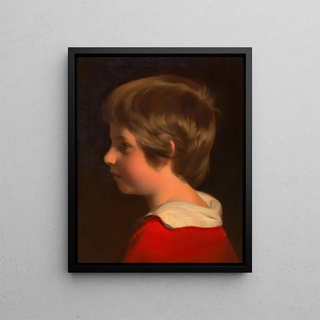Art print | Friedrich Amerling, fils de l'artiste - Friedrich von Amerling


View from behind

Frame (optional)
Friedrich Amerling, son of the artist - Friedrich von Amerling – Captivating introduction
The "Friedrich Amerling, son of the artist - Friedrich von Amerling" painting is a work that resonates with emotional depth and visual delicacy. Capturing the very essence of the portrait, this piece stands out for its ability to tell a story beyond the mere features of the subject. By examining this artwork, the viewer is invited to explore the subtleties of the relationship between father and son, a dynamic expressed through the finesse of details and the richness of colors. The artist, Friedrich von Amerling, succeeds here in transcending the simple portrait to offer a moment of contemplation, an open window into a shared era and feelings.
Style and uniqueness of the work
Friedrich von Amerling's style is imbued with a romantic sensitivity that manifests through harmonious compositions and meticulous attention to detail. In "Friedrich Amerling, son of the artist," light plays a crucial role, illuminating the young man's face with a softness that evokes tenderness and intimacy. The clothing, carefully rendered, testifies to remarkable technical skill, while the nuances of color create a warm and welcoming atmosphere. The subject's posture, both natural and posed, demonstrates mastery of portrait psychology, allowing the observer to feel an almost palpable connection with the model. This artwork stands out for its ability to combine realism and idealization, thus offering a vision that is both intimate and universal of youth and heritage.
The artist and his influence
Friedrich von Amerling, born in 1803 in Vienna, is one of the most respected portraitists of his time. Trained in the vibrant artistic environment of the Austro-Hungarian Empire, he established himself thanks to a style that marries neoclassicism and romanticism. His influence extends well beyond his era, inspiring many contemporary and future artists with his innovative approach to portraiture. Amerling was able to capture not only the physical appearance of his subjects but also their essence, their character. This ability to immortalize fleeting moments, to freeze emotions on canvas, has

Matte finish

View from behind

Frame (optional)
Friedrich Amerling, son of the artist - Friedrich von Amerling – Captivating introduction
The "Friedrich Amerling, son of the artist - Friedrich von Amerling" painting is a work that resonates with emotional depth and visual delicacy. Capturing the very essence of the portrait, this piece stands out for its ability to tell a story beyond the mere features of the subject. By examining this artwork, the viewer is invited to explore the subtleties of the relationship between father and son, a dynamic expressed through the finesse of details and the richness of colors. The artist, Friedrich von Amerling, succeeds here in transcending the simple portrait to offer a moment of contemplation, an open window into a shared era and feelings.
Style and uniqueness of the work
Friedrich von Amerling's style is imbued with a romantic sensitivity that manifests through harmonious compositions and meticulous attention to detail. In "Friedrich Amerling, son of the artist," light plays a crucial role, illuminating the young man's face with a softness that evokes tenderness and intimacy. The clothing, carefully rendered, testifies to remarkable technical skill, while the nuances of color create a warm and welcoming atmosphere. The subject's posture, both natural and posed, demonstrates mastery of portrait psychology, allowing the observer to feel an almost palpable connection with the model. This artwork stands out for its ability to combine realism and idealization, thus offering a vision that is both intimate and universal of youth and heritage.
The artist and his influence
Friedrich von Amerling, born in 1803 in Vienna, is one of the most respected portraitists of his time. Trained in the vibrant artistic environment of the Austro-Hungarian Empire, he established himself thanks to a style that marries neoclassicism and romanticism. His influence extends well beyond his era, inspiring many contemporary and future artists with his innovative approach to portraiture. Amerling was able to capture not only the physical appearance of his subjects but also their essence, their character. This ability to immortalize fleeting moments, to freeze emotions on canvas, has






